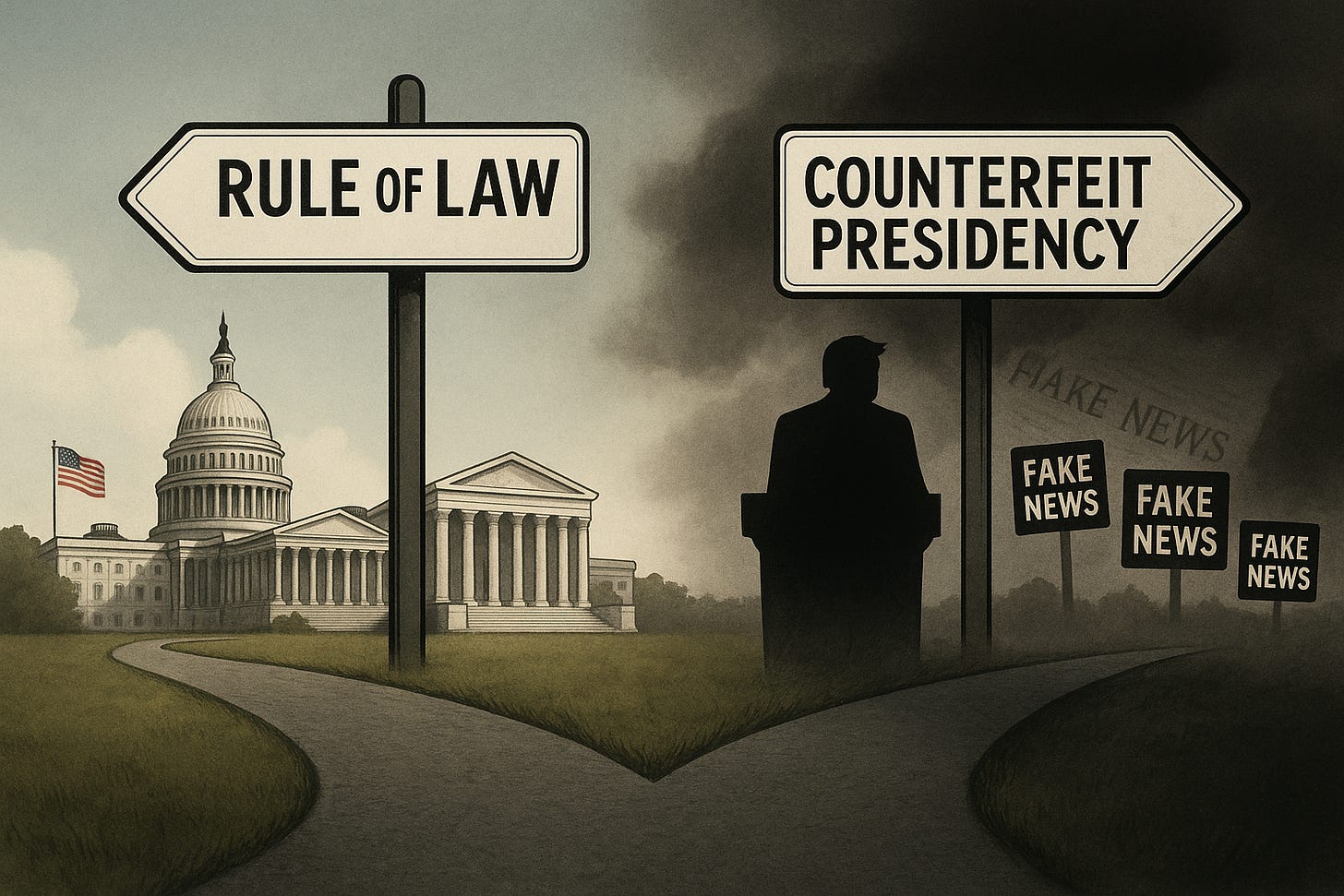✍️The Faux Presidency of Donald Trump
Attacking truth, reshaping power, and rewriting the presidency in plain sight
With absolutely no expertise and certainly no authority on the topic, Donald Trump continues to brand accurate reporting as "fake news." Already a master of narrative manipulation, he’s now weaponizing policy.
During his 2016 campaign and first term, he popularized the phrase to discredit major outlets like CNN, The New York Times, and The Washington Post—especially when their reporting uncovered scandals, legal investigations, or policy failures. And he hasn’t stopped.
It's actually Trump who spews fake news.
According to a Washington Post fact-checking project, he made more than 30,000 false or misleading claims during his first four years in office—many of them while attacking the news media or reshaping reality to fit his narrative.
He still calls “fake” any news that reports accurately on his statements, decisions, and behavior like these:
criminally convicted businessman (for falsifying business records to influence the 2016 election)
civilly convicted sexual abuser (as found by a jury in the E. Jean Carroll case)
twice-impeached president (first for abuse of power in the Ukraine scandal, then for inciting the Jan. 6 insurrection)
former president indicted multiple times (including federal charges for retaining classified documents and attempting to overturn the 2020 election).
He continues that pattern now, weaponizing disinformation to distract, divide, and dominate. Today, in his second term, he’s turning those tactics into law.
The stakes are even higher.
Trump is actively enacting key elements of the Heritage Foundation’s Project 2025—a radical plan to tear down civil service protections, give the president more power, and weaken decades of environmental, civil rights, and labor laws.
Among his most dangerous tools is the reinstatement of Schedule F:
On Jan. 20, 2025, Trump reinstated Executive Order 13957 from his first term, removing job protections from experienced public servants and making it easier to replace them with political loyalists.
This revived Schedule F triggered a backlash, including over a million public comments objecting to the plan to reclassify tens of thousands of career civil servants.
He’s radically reorienting governance.
Trump has already signed more than 160 executive orders this term, many with sweeping effects. Highlights include:
EO14151 (Jan. 20): Abolished all federal diversity, equity, inclusion, and accessibility programs, purged DEI staff, and required agencies to report on staff previously involved
EO14173 (Jan. 21): Revoked anti-discrimination hiring protections for contractors.
EO14215 (Feb 18): Demanded that independent agencies consult the White House on regulations and funding.
EOs in April–May: Ordered nuclear energy expansions (quadrupling capacity by 2050), deregulated drone and supersonic flight industries, and restructured watchdog agencies—including firing a commissioner of the Nuclear Regulatory Commission.
Ongoing moves to freeze over $30B in agency funding, sidestepping Congress under Impoundment Control rules.
His executive orders push or ignore legal limits, openly testing the boundaries of the Constitution. And with his allies challenging judicial oversight and undermining watchdog agencies, those boundaries are fraying.
The so-called Department of Government Efficiency now controls everything from hiring to office supplies—firing people and cutting programs based on politics, not public service.
Meanwhile, the news media remain a central target.
Trump’s administration has escalated efforts to restrict access to critical media outlets, deny press credentials, and label dissenting voices as threats. His cries of “fake news” have shifted from rhetorical jabs to policies of suppression and control.
Fake Authority
If there’s anything to be declared “fake” regarding Donald Trump, it’s not the news. It’s his fake authority and the counterfeit presidency he’s recreating.
What he’s now attempting to normalize is so extreme, so far outside the bounds of the U.S. Constitution and federal law, that it no longer resembles the office created by our founders.
Trump’s presidency represents a dangerous grab for power—firing nonpartisan experts, rewriting the rules, and pretending it’s what the people want.
Some courts, journalists, and members of Congress are pushing back. But it’s not enough. The Constitution works only when we defend it. Without stronger civic engagement, institutional guardrails will continue to weaken.
It’s not just dangerous. It’s also a fraudulent presidency—built on lies, vengeance, and unchecked power.
What We Can Do About This Counterfeit Presidency
Our concern is certainly not fake. And it must become impossible for Trump and his enablers to ignore it:
Stay informed: Follow credible news sources and fact-check information to expose policy changes and threats to democracy. Call out specific EOs, firings, and policy rollbacks as they’re happening.
Pressure Congress and other elected officials: At all levels of government, advocate for the protection of democratic institutions and constitutional checks and balances. Demand hearings on Schedule F, DEIA dismantling, agency funding freezes, and nuclear deregulation.
Support watchdog groups and civic organizations: Contribute to, volunteer with, and amplify groups that defend civil liberties, government accountability, and the rule of law. Tell local leaders to speak out.
Participate in peaceful protests: Continue to join or organize demonstrations to publicly oppose authoritarian policies and protect democratic norms.
Vote—and help others vote: Make your voice heard in every election. Encourage informed civic participation to ensure that leadership reflects the will of the people, not one man’s ambitions.
By taking these steps, we reinforce the foundations of our democracy and send a clear, timely message: Authoritarian overreach will not go unchecked.
Engagement and Action Resources
📌 Progressive Media Sources for News, Ideas, and Action
📌 The Truth Toolkit: Fact-Checking Resources
📌 U.S. Senators & Representatives Contact Info
📌 Executive Overreach & Abuse of Power
A ranked guide to organizations resisting authoritarianism and defending democratic norms.
📌 Reflections on Rights, Power, and Purpose
Explore constitutional values, the role of government, the threats of authoritarianism.


